
* The Vickers Supermarine company of Britain created one of the most famous aircraft of World War II, the Spitfire. In the postwar period, Supermarine moved on to develop a series of jet fighters whose reputations were somewhat mixed and which have been generally forgotten. This document provides a history and description of Supermarine's jet fighters: the Attacker, Swift, and Scimitar.
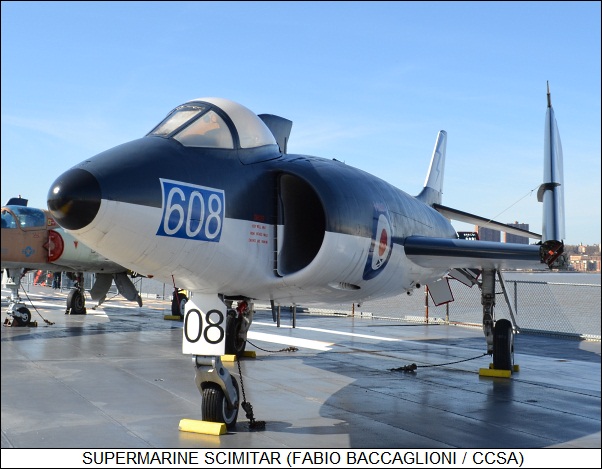
* In 1944, the British Ministry of Supply (MoS) issued Specification E.10/44 for a single-engine jet fighter powered by the Rolls-Royce RB.41 / Nene centrifugal-flow turbojet. A design team at Supermarine led by Joe Smith decided to come up with a design based on the laminar-flow wing and wide-track landing gear of the Supermarine Spiteful -- an enhanced derivative of the famous Spitfire -- with a new fuselage housing the Nene engine.
Development was approved of the aircraft as the "Type 392 Attacker". The initial prototype, tailcode TS409, performed its initial flight on 27 July 1946, with test pilot Jeffrey Quill at the controls. The machine featured a prototype Nene engine with 19.1 kN (1,950 kgp / 4,300 lbf) thrust, fed by inlets on either side of the cockpit, with the exhaust in the tail. Since the Attacker had a tailwheel landing gear configuration, the exhaust tended to tear up the landing strip, so the tailpipe was canted slightly upward to deflect the exhaust flow, without disturbing flight trim.
The MoS issued a second requirement designated E.1/45 for a carrier-based fighter, and so the next two prototypes were navalized "Type 398" machines, using technology derived from the Seafang, the carrier-based derivative of the Spiteful. The second prototype, tailcode TS413, performed its initial flight on 17 June 1947, with test pilot Mike Lithgow at the controls. It was powered by a Nene 3 / Mark 101 turbojet with 22.7 kN (2,315 kgp / 5,100 lbf) thrust. Unlike the first prototype, it featured a Martin-Baker Mark 1 ejection seat, plus a yoke-style arresting hook, long-stroke landing gear, attachments for a catapult strop in the wheel wells, provisions for rocket-assisted take-off gear (RATOG), and lift dumpers / spoilers. The third prototype was built to a similar specification, but had larger and improved engine inlets and the wing moved back 34 centimeters (13.5 inches).
* Production of the navalized Attacker was authorized in September 1948, with the first "Attacker Fighter Mark 1 (F.1)" performing its initial flight on 5 May 1950, and the Attacker F.1 entering service with the Royal Navy Fleet Air Arm (FAA) in August 1951. The F.1 featured all straight flight surfaces, with the wings folding upward in the midspan. The main landing gear, with single wheels, retracted upward from the wings toward the fuselage; the tailwheel was retractable. The tailfin had a forward fillet, added after initial prototype flights demonstrated yaw instability. Armament consisted of twin Hispano Mark V 20-millimeter cannon in each wing, for a total of four cannon. A conformal belly fuel tank with a capacity of 1,136.5 liters (300 US gallons) could be fitted. The canopy slid back to open.
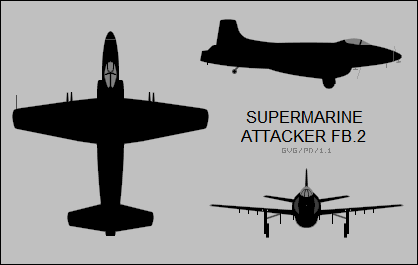
A total of 43 F.1s was built, along with 16 "Fighter-Bomber Mark 1s (FB.1s)" that could carry a warload of two 450-kilogram (1,000-pound) bombs or eight "sixty-pounder" unguided rockets. They were followed in turn by 84 "Attacker FB.2s" -- much the same as the FB.1 but with a framed instead of clear canopy and the Nene 102 engine, with the same thrust as the Nene 101, but with technical fixes. 36 de-navalized Attackers were built for the Royal Pakistan Air Force as well, giving a total production of 3 + 43 + 16 + 84 + 36 = 182 Attackers, including prototypes.
___________________________________________________________________
SUPERMARINE ATTACKER FB.2:
___________________________________________________________________
wingspan:
11.25 meters (36 feet 11 inches)
wing area:
21.03 sq_meters (226.4 sq_feet)
length:
11.43 meters (37 feet 6 inches)
height:
3.02 meters (9 feet 11 inches)
empty weight:
4,495 kilograms (9,910 pounds)
MTO weight:
7,870 kilograms (17,350 pounds)
max speed at altitude:
865 KPH (540 MPH / 470 KT)
max speed at sea level:
950 KPH (590 MPH / 515 KT)
service ceiling:
13,715 meters (45,000 feet)
range with belly tank:
1,915 kilometers (1,190 MI / 1,035 NMI)
___________________________________________________________________
FAA Attackers were usually painted white, with the tops of the fuselage, wings, and tailplane -- but not the tailfin -- painted dark blue. They remained in first-line service into 1954, being retained for two more years in the Volunteer Reserve. Precise details of the Pakistan Attackers are unclear, but it is said they proved unreliable, though they remained in service until 1960. One Attacker was modified by Handley-Page, using General Aircraft as a subcontractor, for trials of the curved "crescent wing" to be fitted on the Handley-Page Victor jet bomber. The demonstrator flew in 1951; it didn't prove very useful, and worse, it broke up in flight after a few months of trials, killing the pilot.
The Attacker was clearly a first-generation jet fighter, being particularly antiquated in terms of its tailwheel landing gear, but its performance was surprisingly better than its stodgy appearance suggested -- Mike Lithgow set a world speed record of 909 KPH (565 MPH) over a 100-kilometer closed course in the Attacker on 27 February 1948. It did give the FAA initial experience in carrier jet fighter operations.
BACK_TO_TOP* The fact that the Attacker was a stodgy design meant there was room for improvement. In response to Specification E.41/46 for an experimental high-speed fighter demonstrator, Supermarine submitted a design for what amounted to a swept-wing Attacker, and in response received a contract to build two prototypes, with the first, the "Type 510", performing its initial flight on 29 December 1948, with Mike Lithgow at the controls. It had the Attacker-style fuselage but with all-swept flight surfaces; it retained the Nene 3 engine and tailwheel landing gear of the Attacker. There was provision for four wing-mounted Hispano Mark V cannon, but weapons were not fitted.
Test pilots reported the aircraft's handling and performance were pleasing -- it came off well in trials against a North American F-86A Sabre -- but some improvements in flight control, as well as tricycle landing gear, were required. The second prototype, the "Type 528", performed its initial flight on 27 March 1950. Its configuration was similar to that of the Type 510's initial configuration.
The initial Type 510 prototype underwent alterations in the course of trials, initially receiving carrier kit such as catapult strop attachments and yoke-style style arresting hook, allowing it to perform take-offs and landings on the HMS ILLUSTRIOUS on 8 November 1950, and then being fitted with an adjustable-incidence tailplane, to be designated "Type 517".
In the meantime, the Type 528 underwent some alterations as well, being fitted with an afterburning Nene developed by Supermarine, a longer nose, and tricycle landing gear, to become the "Type 535". It performed its initial flight in this form on 23 August 1950. The Type 535 was seen as promising; while the British Royal Air Force (RAF) was more interested in the Hawker P.1067, which would become the famous Hawker Hunter, the Type 535 was ordered into production in November 1950 as a backup. It was given the name of "Swift".
The Type 535 seemed to be a robust aircraft, and converting it into a production aircraft was seen as straightforward. The production aircraft was to have four-cannon armament and, significantly, the powerplant changed from the afterburning Nene to the Rolls-Royce "Axial Jet 65 (AJ.65)", which would become known as the "Avon". The Avon offered about 50% more thrust; as an axial-flow engine, it was much slimmer than the portly centrifugal-flow Nene, but as a fast-track project the fuselage wasn't redesigned, which incidentally left considerable volume available for fuel tanks.
Two "Type 541" pre-production prototypes were ordered, along with a batch of "Swift Fighter Mark 1 (F.1)" production machines. Since the Korean War was in progress, second-source production was arranged from other manufacturers, with a projected 1,200 Swifts to be built. The initial Type 541 prototype performed its first flight on 1 August 1951. The second Type 541 prototype, which was much closer to production spec, performed its first flight on 18 July 1952.
BACK_TO_TOP* The first production Swift F.1 performed its initial flight on 25 August 1952. The F.1 featured twin 30-millimeter Aden revolver-type cannon, with one cannon under each engine inlet, and was powered by a non-afterburning Avon 108 turbojet, providing a maximum thrust of 33.4 kN (7,500 kgp / 15,436 lbf). Only 20 were built; nine ended up in RAF service from February 1954, becoming the RAF's first swept-wing fighter. The rest were used for trials and evaluation.
By this time, it was becoming apparent that all was not right with the Swift. The British were charging ahead with the program and paid little mind to a US Air Force evaluation that reported the Swift suffered from controllability problems at high speeds. Engine failures were extremely common. All this was shrugged off as normal teething problems with a new aircraft, but when the Swift F.1 went into service with the RAF, it was subject to a level of flight restrictions that rendered it operationally useless.
The F.1 was followed by the "Swift F.2", which was much the same except that two more Aden cannon were fitted under the belly not far from the engine inlets, giving a total armament of four cannon. To accommodate the ammunition for the new cannon, the wingroot was extended, giving a steeper wing sweep inboard and a "kinked" wing profile. 16 F.2s were built, with deliveries to the RAF from August 1954. The F.2 turned out to be even less airworthy than the F.1, with the modified wing causing uncontrolled "pitch up" at high speeds. The nose was ballasted to help reduce the problem, though that didn't do anything to improve the Swift's handling.
The F.2 was followed in turn by the "Swift F.3", which was much the same in turn as the F.2 except that it was powered by an afterburning Avon 114 turbojet, which had been trialed on one of the Swift F.1s. The Avon 114 provided 31.9 kN (3,255 kgp / 7,175 lbf) dry thrust and 42.1 kN (4,285 kgp / 9,450 lbf) afterburning thrust. The F.3 also featured a fence on each wing just outboard of the "kink", and was later refitted with vortex generator surfaces on the top and bottom of the tailplane to help correct the pitch-up problem. 25 F.3s were built, but unfortunately it turned out that the afterburner couldn't be engaged above 6,100 meters (20,000 feet) -- not exactly an attractive feature in a high-altitude interceptor. The F.3s were delivered to storage and later used as ground-instruction airframes.
The amount of stress Supermarine's engineering team must have been under at the time can only be faintly imagined. The next variant was the "Swift F.4", much like the F.3 except that it had an adjustable-incidence tailplane, added as yet another fix for the pitch-up problem. A mere eight were built; the new tailplane did help, but the afterburner problems remained. Worse, the RAF found all the Swifts in service to be "hangar queens", with engineers and ground crew hard-pressed to keep even half of them flying.
In early February 1955, the RAF passed up a memo to the government indicating that the Swift should not be accepted into formal service, and on 23 February 1955, the government publicly announced the failure of the program. On 15 March 1955, the fighter Swifts were ordered withdrawn from flight service. There were problems getting the Hawker Hunter into proper service as well, but it was much more promising than the Swift, and indeed would mature into an outstanding combat aircraft. The decision to give up on the Swift as a fighter was hard to argue with.
BACK_TO_TOP* Some authors have suggested that the Type 535, with the afterburning Nene, seemed to be a fairly robust aircraft, and much pain could have been avoided if it had been put into production "as was" -- giving the RAF a fighter with leading-edge performance for the early 1950s and providing an effective stepping-stone to the Hunter. That didn't happen, and the whole Swift saga became a classic story of great expectations supported by little but wishful thinking, ending in a dreadful crash.
The Swift is now remembered as a nasty dog of an aircraft, but in fact the black cloud had something of a silver lining. Although the Swift flew badly at altitude, it performed well down in the treetops -- Mike Lithgow had set a world speed record of 1,183.5 KPH (735.4 MPH) over a low-level course on 26 September 1953, though the Americans beat it the next day with their new Douglas F4D Skyray. The Swift's fat fuselage gave it plenty of fuel capacity and a good radius of action.
The RAF had a need for a tactical reconnaissance platform -- the service's Meteor PR.9s were obsolescent and generally getting weary, and priority for the manufacture of fighter Hunters meant that a reconnaissance Hunter wouldn't be available for a few years. Work on a reconnaissance Swift was authorized, with one of the Swift F.1s modified to become the prototype of the "Type 549 Swift Fighter-Reconnaissance Mark 5 (FR.5)".
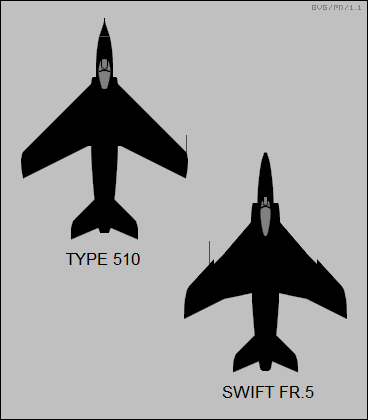
The modified F.1 was just a demonstrator, the only major change being fit of a lengthened nose housing three Vinten F95 film cameras, arranged to stare left-down-right. An F.4 was then modified as a more complete prototype, featuring the camera nose; a taller tailfin to compensate for the longer nose; a dogtooth wing without the wing fences; and a bubble canopy, instead of the framed canopy used on earlier Swifts. The afterburning Avon 114 engine was retained, though armament reverted to the twin Aden cannon of the F.1. A conformal belly fuel tank with a capacity of 1,000 liters (264 US gallons) could be fitted.
___________________________________________________________________
SUPERMARINE SWIFT FR.5:
___________________________________________________________________
wingspan:
9.86 meters (32 feet 4 inches)
wing area:
32.32 sq_meters (347.9 sq_feet)
length:
12.88 meters (42 feet 3 inches)
height:
4.03 meters (13 feet 2 inches)
empty weight:
6,230 kilograms (13,735 pounds)
MTO weight:
9,750 kilograms (21,500 pounds)
max speed at altitude:
1,000 KPH (685 MPH / 595 KT)
service ceiling:
13,960 meters (45,800 feet)
range (no belly tank):
825 kilometers (512 MI / 445 NMI)
___________________________________________________________________
After the fiasco with the fighter Swift, the FR.5 was given a thorough evaluation to make sure it met spec. The first four were delivered in December 1955, with a total of 102 built -- including 39 machines that had been ordered as F.4s but completed as FR.5s, and four conversions from F.4s. The FR.5s effectively only operated with RAF Germany, with the Meteor PR.9 continuing to serve in the Middle East and Far East, where the potential opposition was not as formidable. Swift FR.5s were generally painted in disruptive gray and green camouflage topside, with sky blue underneath. They were finally retired in 1960, having been replaced by the Hunter FR.10.
The Swift FR.5 was fondly remembered by its pilots, some of them even preferring it to the Hunter FR.10. It was a solid, fast ride down in the treetops, and despite the unreliability of the fighter Swifts, turned out to be very strong and trustworthy. Swifts often won competitions, and their pilots could become very exuberant -- two ended up on charges when they flew under a bridge on the Kiel canal. The charges were dropped when the investigating officer went to the bridge to give it a looking-over, and saw four de Havilland Venom fighters pulling the same trick; obviously, the RAF couldn't court-martial everyone, though no doubt stern warnings were issued to tell the pilots to knock it off.
* A high-altitude photo-reconnaissance version of the Swift, the "PR.6", was considered in parallel with the FR.5, but the dismal showing of the fighter Swifts at altitude mean it went down the pipes with them. A prototype of the PR.6 was almost complete when the program was canceled in April 1954. There were also schemes for a true supersonic Swift, though the design ended up being so altered that it was effectively a new aircraft; a two-seat trainer version; a two-seat radar-equipped night fighter version; and a carrier-based version. None of them happened.
However, somewhat surprisingly another Swift fighter, the "Type 552 Swift F.7", was actually built. As the Swift fighter saga was progressing to its unfortunate conclusion, there were plans for a Swift armed with four Fairey Blue Sky / Fireflash beam-riding air-to-air missiles (AAMs). Even after cancellation of the Swift fighter effort, the Swift was seen as a good platform for performing trials with the Fireflash. Two F.7 prototypes were delivered in 1956, followed by 12 "production" machines in 1957. Cannon armament was deleted, permitting more internal fuel accommodation. The F.7s had an extended nose to house the Ekco radar for the Fireflash AAM, stretching the length to 13.42 meters (feet); the wingspan was also extended to 11 meters (36 feet 1 inch).
It is an indication of how much cheaper it was to build a combat aircraft in those days to realize how unimaginable it would be these days to produce 14 jet fighters strictly to perform weapons trials. The trials went well, but the Firestreak heat-seeking AAM was preferred, and the Fireflash didn't enter production. The Swift F.7s were retired in 1958. A number of Swifts survive as museum exhibits today, but none of them are flightworthy.
BACK_TO_TOP* While Supermarine worked on the Attacker and then the Swift, the company also pursued a twin-jet heavy carrier-based fighter design. At the end of World War II, the Royal Navy was interested in a "flexible deck" concept, in which aircraft carriers would have a "soft" deck to allow aircraft to land without undercarriage, the advantage being less weight required for landing gear and so better performance. Take-offs would be performed on a catapult trolley.
In response to this concept, Supermarine came up with a single-seat fighter, the "Type 505", with a low straight wing; a vee or "butterfly" tail; and twin Rolls-Royce AJ65 / Avon axial-flow engines, one on a nacelle on each side of the fuselage, with "pen-nib" fairings behind the engine exhausts to protect the rear fuselage. For prototype development, the design featured fixed tricycle landing gear. That proved fortunate, since by late 1947 the Royal Navy had given up on the flexible deck concept -- the landings weren't such a problem in themselves, but it was a pain to drag around an aircraft after it landed, and of course it could only land on a flexible deck. It wasn't any real problem to modify the Type 505 for retractable tricycle landing gear. Three prototypes were ordered in response to Specification N.9/47.
The first prototype, the "Type 508", performed its initial flight on 31 August 1951, with the second, the generally similar "Type 509", performing its initial flight on 31 August 1951, with (of course) Mike Lithgow at the controls. It was powered by two non-afterburning Avon RA.3 turbojets, each providing 28.97 kN (2,950 kgp / 6,500 lbf) thrust; span was 12.5 meters (41 feet), length was 15.24 meters (50 feet), and normal loaded weight was 8,550 kilograms (18,850 pounds). Top speed was disappointing, 970 KPH (603 MPH) at altitude, and the aircraft demonstrated a bit of "snaking", which was blamed on the butterfly tail.
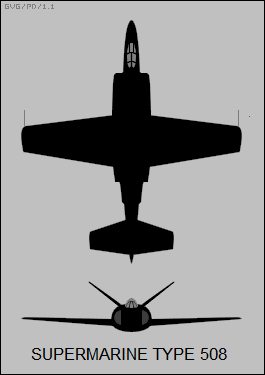
The second prototype, the "Type 529", performed its initial flight on 29 August 1952. It looked much like the first, but it featured many small design changes and, unlike the first prototype, was armed, with four 30-millimeter Aden cannon, two beneath each engine inlet. The two prototypes went on to carrier trials, though the Type 529 was damaged beyond repair in an emergency landing on 2 December 1953. The Type 508 remained in trials service into 1956 and was ultimately scrapped.
* Even before the first flight of the Type 508, plans were being made to build the third prototype with swept wings as the "Type 525". There were considerations of building the Type 525 with either the vee tail or more conventional swept tail assembly, with an "all moving" tailplane; the conventional tail assembly won out. The swept wing was to have big trailing-edge flaps and full-span leading-edge flaps to give it good take-off and landing capability. On reviewing the design with the customer, the word came down to add "boundary layer control (BLC)" or "flap blowing", in which engine bleed air was driven over the tops of the flaps to improve low-speed performance.
Initial flight of the Type 525 was on 27 April 1954, once again with Lithgow at the controls. It was the biggest single-seat fighter the British had ever built; although the twin Avons provided plenty of thrust, it was still subsonic, though it could break Mach 1 in a dive. Unfortunately, the Type 525 was lost in an accident on 5 July 1955, the pilot being killed. The tragic accident delayed the program by almost two years.
Development did continue, with Supermarine working on three refined "Type 544" prototypes, with a longer nose, dorsal spine, and area-ruled fuselage. The first performed its initial flight on 20 January 1956, yet again with Lithgow at the controls. It was almost lost during carrier trials on 9 April, when a Royal Navy pilot forgot to release the parking brake while he took a catapult shot. He managed to struggle up into the sky, though the HMS ARK ROYAL retained the skid marks for some time as an embarrassing reminder. The other Type 544 prototypes followed in June and October 1956.
The Type 544 prototypes demonstrated a number of handling faults, with the result that the wing was modified to feature a dogtooth with a fence on each wing, while the tail assembly was generally revised. The fixes were satisfactory -- the slipshod evaluation that had killed the Swift fighter wasn't going to be repeated -- and the Type 544 was ordered into production as the "Scimitar F.1" in March 1957, with the initial production aircraft performing its first flight on 11 January 1957. A total of 100 was ordered, though only 76 were actually built, with final delivery in March 1961.
BACK_TO_TOP* The Scimitar, as mentioned, was a twin-engine fighter with all-swept flight surfaces, flaps with BLC, full-span leading-edge flaps, and an all-moving tailplane. Construction was mostly of aircraft aluminum -- with innovative "chemical machining" using chemical etch to provide highly precise figures -- though the three spars in each wing were high-strength steel, and some titanium was used. It was the first British aircraft built with titanium.
The powerplants were twin nonafterburning Rolls-Royce Avon RA.28 / Mark 202 turbojets, each providing 50.0 kN (5,100 kgp / 11,250 lbf) thrust. Some American critics suggested that it was peculiarly British to put 100 kN of thrust into a jet fighter and still fail to achieve supersonic performance -- but even with engine bleed for the BLC system, there was no lack of power to get the Scimitar off the deck. At low altitude it could outpace a McDonnell Phantom, some claim even with one engine idled. Internal fuel capacity was 4,837 liters (1,276 US gallons / 1,064 Imperial gallons). An inflight refueling probe could be fitted to the nose.
The wing had a 45-degree sweep at quarter chord, and had a chord-to-thickness ratio of 8% at the wingroot -- which is one of the reasons it couldn't achieve supersonic performance. The wings folded straight up hydraulically at midspan. There was a hydraulically-actuated airbrake on each side of the rear fuselage. The tailplanes had a 10-degree anhedral droop -- incidentally, the Type 525's tailplanes had 10-degree dihedral. All flight controls were hydraulically powered, with an "artificial feel" system developed to provide tactile feedback for the pilot.
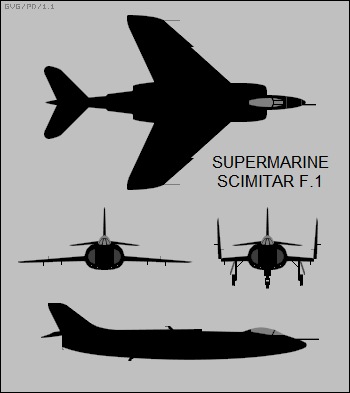
The tricycle landing gear all featured single wheels, with the gear assemblies hydraulically retracted, the main gear hinging in the wings toward the fuselage and the nosewheel retracting backwards. There was a stinger-style arresting hook under the tail, along with a retractable tail bumper. The pilot sat in a pressurized and climate-conditioned cockpit on a Martin-Baker Mark 4C ejection seat, with the canopy sliding back to open.
___________________________________________________________________
SUPERMARINE SCIMITAR F.1:
___________________________________________________________________
wingspan:
11.33 meters (37 feet 2 inches)
wing area:
45.06 sq_meters (485 sq_feet)
length:
16.87 meters (55 feet 4 inches)
height:
5.28 meters (17 feet 4 inches)
empty weight:
10,870 kilograms (23,960 pounds)
MTO weight:
15,515 kilograms (34,200 pounds)
max speed at sea level:
1,145 KPH (710 MPH / 615 KT)
service ceiling:
14,020 meters (46,000 feet)
range:
2,290 kilometers (1,420 MI / 1,235 NMI)
___________________________________________________________________
Armament consisted of four 30-millimeter Aden cannon under the engine inlets, with 160 rounds per gun; discarded cases and links were stored in a compartment instead of discarded, to prevent damage to the aircraft. There were also four stores pylons, two on each wing. All the stores pylons were "wet" and each could be used to carry an external fuel tank with a capacity of 909 liters (240 US gallons / 200 Imperial gallons). The Scimitar had been originally planned for the air combat role, with the four cannon complemented by four packs containing 24 unguided rockets each. From 1963, Scimitars were wired for carriage of US-built Sidewinder air-to-air missiles (AAMs); all four pylons were wired, giving a total load of four Sidewinders, but a more usual fit was two external tanks and two Sidewinders.
However, by the time the Scimitar went into service, it was obsolescent in the air combat role, and its high-altitude performance was poor anyway; the de Havilland Sea Vixen quickly took that role as its own. Work had been done on a two-seat Scimitar interceptor with radar, but the Sea Vixen rendered that exercise pointless. The Scimitar was mainly used as a low-altitude strike fighter, in particular for "toss bombing" of the Red Beard nuclear munition -- in which the Scimitar released the bomb in a climb, and then turned around to exit the blast area in haste as the munition sailed up and then back down. Scimitars configured for Red Beard carriage featured a "low altitude bombing system (LABS)", featuring a toss-bombing computer and a Blue Silk Doppler navigation radar -- the Scimitar otherwise lacked radar.
For conventional strike, Scimitars could carry unguided rocket packs or up to four 450-kilogram (1,000-pound) bombs, and were trialed with twin 900-kilogram (2,000-pound) bombs. Scimitars were configured from the early 1960s to carry the US Bullpup radio-guided air-to-surface missile; it is unclear if the guidance system for the Bullpup was installed into the aircraft or carried in a pod on a stores pylon. The Scimitar could also be and often was used as an inflight refueling tanker, carrying a Flight Refueling Mark 20 tanker pack. In addition, the aircraft could be used in the photo-reconnaissance role by being refitted with a camera nose.
* Scimitars in service were painted dark blue on top and white on the bottom. For catapult take-off, a Scimitar was strapped down with its nosewheel in the air -- a procedure common among many Royal Navy jets, the rationale being that it aided take-offs on short carrier decks.
Most pilots apparently liked the big, sturdy, powerful, and noisy Scimitar, but some didn't care much for it, since it was a very unforgiving machine to fly -- of the 76 Scimitars built, ultimately 37 were lost in accidents, killing nine pilots. It was given the nickname "Beast", it seems partly in respect and partly in contempt. The first-line service of the Scimitar was brief, the type being phased out as it was replaced by the superlative Blackburn Buccaneer in the low-level attack role. The Scimitar remained in service for a few years as a tanker and in training roles. The Scimitar was completely withdrawn from service in 1970. A handful survive as museum displays.
BACK_TO_TOP* The following list summarizes Supermarine's combat jets:
* Sources include:
* Revision history:
v1.0.0 / 01 mar 08 v1.0.1 / 01 feb 10 / Review & polish. v1.0.2 / 01 feb 10 / Review & polish. v1.0.3 / 01 jan 12 / Review & polish. v1.0.4 / 01 dec 13 / Review & polish. v1.0.5 / 01 nov 15 / Review & polish. v1.0.6 / 01 oct 17 / Review & polish. v1.0.7 / 01 sep 19 / Review & polish. v1.0.8 / 01 jul 21 / Review & polish. v1.0.9 / 01 jun 23 / Review & polish. v1.1.0 / 01 jun 25 / Review & polish.BACK_TO_TOP
